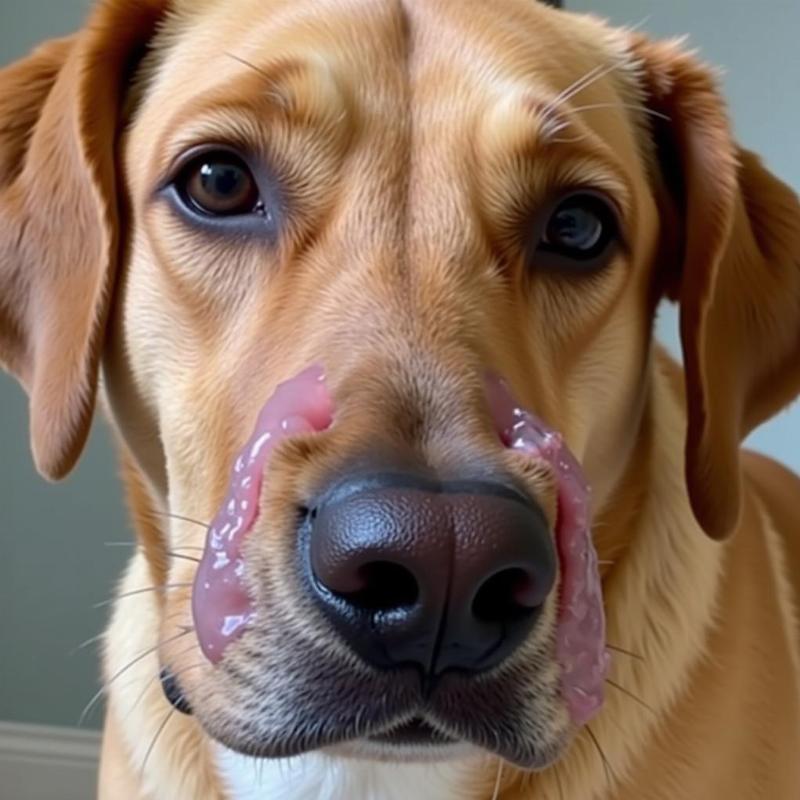A bee sting can be a painful experience for anyone, including our furry friends. If your dog has been stung by a bee, you’re likely concerned and searching for information about dog bee sting recovery time. Understanding the typical recovery process, recognizing signs of a severe reaction, and knowing how to provide appropriate care are crucial for ensuring your dog’s well-being. This article will guide you through everything you need to know about dog bee stings, from initial reaction to full recovery.
Bee stings in dogs are relatively common, especially during warmer months when bees are most active. Most dogs experience localized swelling, pain, and redness at the sting site. The dog bee sting recovery time for these mild reactions is typically short, ranging from a few hours to a couple of days. However, some dogs can have more severe reactions, ranging from extensive swelling to life-threatening anaphylaxis. Knowing what to look for and how to react can make all the difference.
Understanding the Initial Reaction and Swelling
When a bee stings a dog, it injects venom into the skin. This venom causes the initial pain, redness, and swelling. You might notice your dog licking or pawing at the sting site, a clear indication of discomfort. If the sting is on the paw, your dog might limp or hold the paw up. For stings on the face or muzzle, swelling can be more pronounced and concerning.
 Dog with swollen face from bee sting
Dog with swollen face from bee sting
Dog Bee Sting Recovery Time: Typical Timeline
In most cases, the initial pain and swelling from a bee sting will subside within a few hours. The redness and localized swelling may persist for a day or two, gradually decreasing in size. During this time, it’s important to monitor the area for any signs of infection, such as increased redness, heat, pus, or a foul odor.
Signs of a Severe Allergic Reaction
While most bee stings cause only mild discomfort, some dogs can experience a severe allergic reaction known as anaphylaxis. This is a life-threatening emergency and requires immediate veterinary attention. Signs of anaphylaxis include:
- Difficulty breathing
- Facial swelling, especially around the muzzle and eyes
- Hives or welts on the skin
- Vomiting
- Diarrhea
- Collapse
If your dog displays any of these symptoms, seek veterinary care immediately.
First Aid and Home Care for Bee Stings
If you can locate the stinger, try to remove it by scraping it away with a credit card or your fingernail. Avoid squeezing the stinger, as this can release more venom. You can apply a cold compress to the area to help reduce swelling and pain. A paste of baking soda and water can also help neutralize the venom and soothe the skin.
When to Seek Veterinary Care
While most bee stings can be managed at home, there are certain situations where veterinary care is necessary. These include:
- Multiple bee stings
- Stings inside the mouth or throat
- Signs of an allergic reaction
- Swelling that doesn’t improve after a few days
- Signs of infection
Your veterinarian can provide pain relief, administer antihistamines to reduce swelling, and prescribe antibiotics if necessary.
Preventing Bee Stings
Keeping your dog away from areas where bees are likely to congregate, such as flowering plants and garbage cans, can help prevent stings. Regularly checking your yard for beehives and having them professionally removed is also important.
Conclusion
Knowing the typical dog bee sting recovery time and recognizing the signs of a more serious reaction can help you provide the best possible care for your furry friend. While most bee stings result in mild, localized reactions that resolve within a few days, prompt veterinary attention is crucial for severe allergic reactions. By taking preventative measures and knowing how to respond appropriately, you can help ensure your dog stays safe and comfortable during the warmer months.
FAQ
- How long does it take for a dog bee sting to go down? Typically, swelling and redness will subside within a few hours to a couple of days.
- What can I give my dog for a bee sting? You can apply a cold compress and a paste of baking soda and water. Avoid giving any medications without consulting your veterinarian.
- Can a bee sting kill a dog? Yes, if the dog has a severe allergic reaction and doesn’t receive prompt veterinary care.
- What does a bee sting look like on a dog? You’ll typically see redness, swelling, and possibly a small puncture wound at the sting site.
- How can I tell if my dog is allergic to bee stings? Signs of an allergic reaction include difficulty breathing, facial swelling, hives, vomiting, diarrhea, and collapse.
- Can I use Benadryl for a dog bee sting? Consult with your vet before giving any medication, including Benadryl, to your dog.
- What if my dog eats a bee? If your dog eats a bee, monitor for swelling in the mouth or throat, and contact your veterinarian if any signs of distress appear.
Beautdogs.us is your premier online resource for comprehensive dog care information, breed-specific guidance, and product recommendations in the United States. We cater to both novice and experienced dog owners, providing expert advice on all aspects of dog ownership. For personalized support, reach out to us via email at [email protected] or by phone at +1 501-555-7529. Beautdogs.us is committed to empowering you with the knowledge and resources needed to ensure your dog lives a happy, healthy, and fulfilling life.